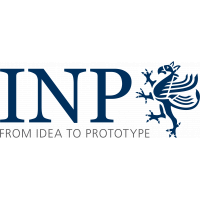The data set comprises full cavity ring-down spectra and absorption coefficients obtained from on-off-resonance measurements, in order to determine the spatial distribution of HO₂ in the cold atmospheric pressure plasma jet kINPen-sci. Therefore, the plasma jet was operated with 3 slm Ar and 3000 ppm water, and was equipped with a gas curtain of 5 slm O₂. To determine the effective absorption length, the HO₂ absorption was measured in radial direction. These radial fits had a Gaussian-like shape. By performing Abel inversion on the Gaussian fits, spatial distributions of HO₂ in x and y and in x and z direction were obtained.
| Field | Value |
|---|---|
| Group | |
| Authors | |
| Release Date | 2021-09-22 |
| Identifier | 3f1fdda6-ee52-4f4c-b45f-03ee827a8534 |
| Permanent Identifier (DOI) | |
| Permanent Identifier (URI) | |
| Is supplementing | |
| Plasma Source Name | |
| Plasma Source Application | |
| Plasma Source Specification | |
| Plasma Source Properties | Frequency: ~1 MHz; Power: 1-3 W |
| Plasma Medium Name | |
| Plasma Medium Properties | Feed gas: 3 slm Ar with 3000 ppm humidity; Gas curtain: 5 slm O2 |
| Plasma Medium Procedure | 10% of the Ar flow was guided through a water bubbler held at room temperature. In order to control the effluent’s surrounding gas environment, the kINPen-sci was equipped with a gas curtain device. |
| Plasma Diagnostics Name | |
| Plasma Diagnostics Properties | Spatially resolved continuous wave cavity ring-down spectroscopy (cw-CRDS) at a laser wavelength λ = 6638.2 cm-1 (1506 nm) |
| Plasma Diagnostics Procedure | The distributed feedback diode laser was directed via an adjustable fibre collimation package (CFC-8X-C, Thorlabs) and two protected silver coated mirrors into the optical cavity, consisting of two high reflectivity mirrors (Layertec, reflectivity R = 99.998%, radius of curvaturer = 1 m). These mirrors were separated by a distance of L = 80 cm, yielding a minimum beam diameter of 1 mm in the centre of the cavity. The output mirror was mounted on a hollow cylindrical piezoelectric transducer so that the length of the cavity could be modulated by a few laser wavelengths. The exiting light was then focused with an off-axis parabolic mirror onto an InGaAs photodiode (DET10C, Thorlabs), whose photocurrent was amplified by a transimpedance amplifier (DLPCA-200, FEMTO) and sent to a home-built trigger circuit. The spatial resolution in radial direction was obtained after performing Abel inversion. To determine the spatial distribution the on/off-resonance method was employed (see the description in the publication). |
| Language | English |
| License | |
| Public Access Level | Public |
| Contact Name | Klose, Sarah-Johanna |
| Contact Email |
Data and Resources
- Spatial distribution of HO₂ in APPJ - Fig. 3csv
The cavity losses 1/cτ as a function of the wavenumber for different z-...
Preview Download - Spatial distribution of HO₂ in APPJ - Fig. 4csv
Baseline corrected absorption coefficient spectrum for 3 slm Ar with 3000...
Preview Download - Spatial distribution of HO₂ in APPJ - Fig. 5csv
Δα as a function of z at x = 0 mm, obtained from on-off-resonance...
Preview Download - Spatial distribution of HO₂ in APPJ - Fig. 6acsv
Δα as a function of x at z = 2 mm together with Gaussian fits - see Fig 6 in...
Preview Download - Spatial distribution of HO₂ in APPJ - Fig. 6bcsv
Δα as a function of x at z = 4 mm together with Gaussian fits - see Fig 6 in...
Preview Download - Spatial distribution of HO₂ in APPJ - Fig. 6ccsv
Δα as a function of x at z = 6 mm together with Gaussian fits - see Fig 6 in...
Preview Download - Spatial distribution of HO₂ in APPJ - Fig. 6dcsv
Δα as a function of x at z = 8 mm together with Gaussian fits - see Fig 6...
Preview Download - Spatial distribution of HO₂ in APPJ - Fig. 6ecsv
Δα as a function of x at z = 10 mm together with Gaussian fits - see Fig 6...
Preview Download - Spatial distribution of HO₂ in APPJ - Fig. 7csv
Line-of-sight averaged density of HO₂ as a function of z at x = 0 mm...
Preview Download - Spatial distribution of HO₂ in APPJ - Fig. 8csv
Density of HO₂ as a function of x for y = 0 and z = 2; 4; 6; 8; and 10 mm -...
Preview Download - Spatial distribution of HO₂ in APPJ - Fig. 9csv
Density distribution of HO₂ as a function of x (-5.26 mm to 4.74 mm, Δx = 0....
Preview Download - Spatial distribution of HO₂ in APPJ - Fig. 10acsv
Localised density of HO₂ illustrated in two different planes cut along the...
Preview Download - Spatial distribution of HO₂ in APPJ - Fig. 10bcsv
Localised density of HO₂ illustrated in two different planes cut along the...
Preview Download

![[Open Data]](https://assets.okfn.org/images/ok_buttons/od_80x15_blue.png)